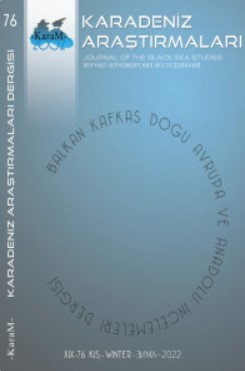RUS EDEBİYATINDA TARİHÎ KÜLTÜREL BİR SEMBOL OLARAK YATAĞAN KILICI
THE YATAGHAN SWORD AS A HISTORICAL CULTURAL SYMBOL IN THE RUSSIAN LITERATURE
Author(s): Esra ELMACIOĞLU, Sonnur AktaySubject(s): Cultural history, Military history, Comparative Study of Literature, Russian Literature, Theory of Literature
Published by: Karadeniz Araştırmaları Merkezi
Keywords: Russian Literature; Turkish Soldier Image; Janissary; Yataghan Sword; Military Terms;
Summary/Abstract: From past to present, relations between Russia and Turkey have varied depending on political, economic and cultural factors. In the historical process, it is seen that the ups and downs between two countries are based on important wars in the XVIII and XIX centuries. For Russians, Turks are anti-Russian warriors within the framework of the aforementioned Turkish-Russian wars. The enemy Ottoman-Turk image, which was dealt with on the basis of the Turkish-Russian wars, their reflections in many works in Russian literature. As a janissary, the Turkish soldier finds a place in M. N. Zagoskin's story An Evening on the Hopyor (Вечер на Хопре) in 1834 and in A. S. Pushkin's Kardzhali (Кирджали) story in the same year. In the mentioned works, the weapons used by the Janissaries and their brutal attitudes draw attention. Janissaries and especially their swords, which are defined as yataghan, were reflected in the literature of the period as frequently repeated images. The image of yataghan and the janissary continued to be used as the main subject of the works written about the Turkish-Russian war and as an indispensable characteristic of the Turkish soldier. The effects of this can be seen in Pavlov's long story titled Yataghan (Ятаган) published in 1835. Another work written as a continuation of the Turkish-Russian wars is the novel Bayezid (Баязет) written by V. S. Pikul in 1959-1960 years. The Turkish soldier, who left a mark in history with his success, found a place in Russian literature with the image of the janissary. The subject of this study is to show how the janissaries, who are considered as a prototype of the Turkish soldier – as enemy of Russian folk, and the yataghan sword, which is shown as the main war material, are reflected in the works titled An Evening on the Hopyor, Kardzhali, Yataghan and Bayezid. Thus, the Janissary factor in the Turkish-Russian wars and the weapons used in the period will allow us to learn about the perspective of the Turkish soldier in Russian literary works. At the same time, in the context of historical and cultural interaction, the reflection of the qualities attributed to the Turkish soldier to the Russian vocabulary will be examined.
Journal: Karadeniz Araştırmaları
- Issue Year: 2022
- Issue No: 76
- Page Range: 1233-1243
- Page Count: 11
- Language: Turkish

